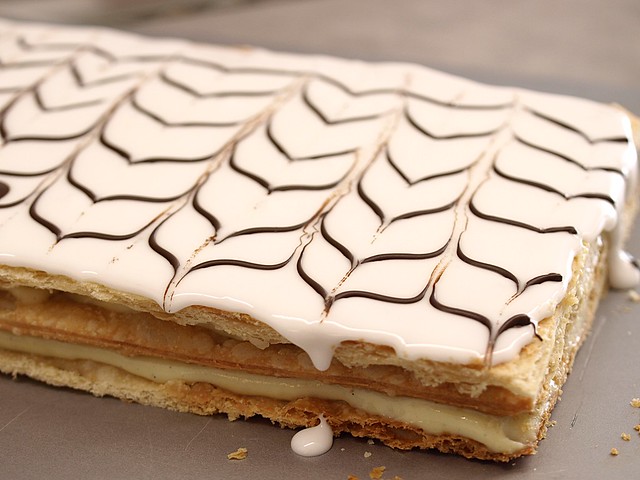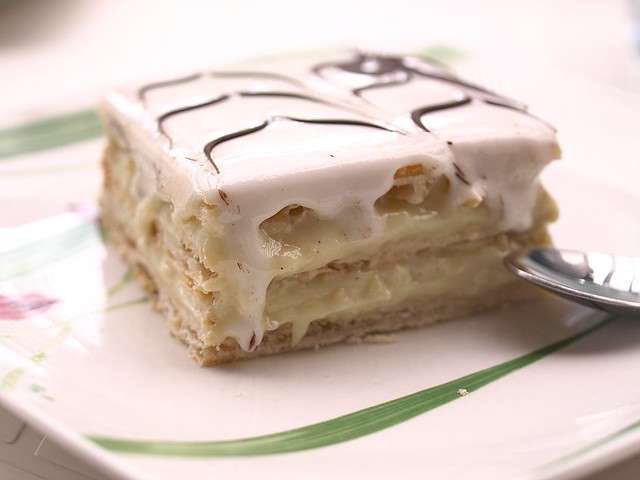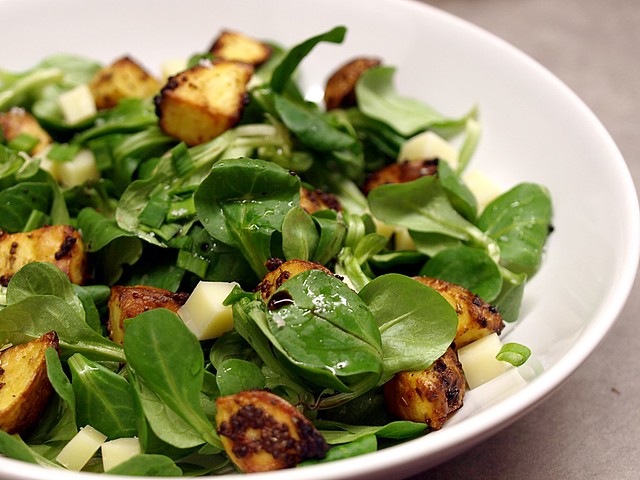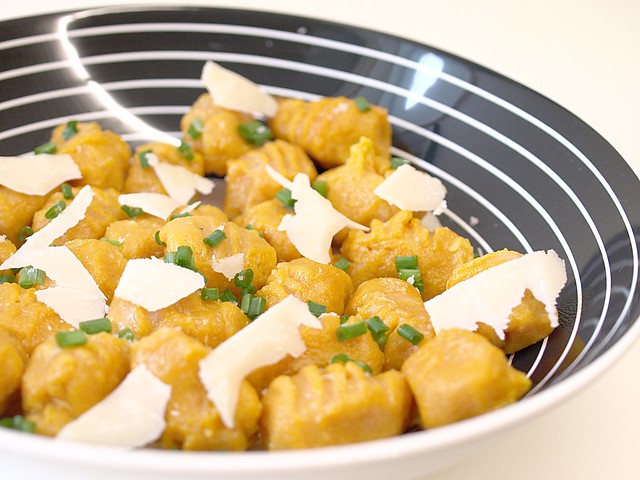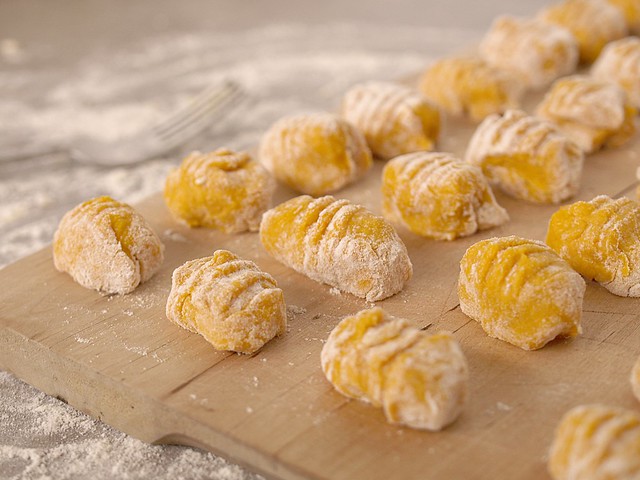27/10/2012
Daring Baker - October 2012 Challenge: Mille-Feuille
Our October 2012 Daring Bakers’ challenge was hosted by Suz of Serenely Full. Suz challenged us to not only tackle buttery and flaky puff pastry, but then take it step further and create a sinfully delicious Mille Feuille dessert with it!
And this one was quite challenging! Making a Mille Feuille was on my list for a long time, and the good thing about participating in a challenge like this, is that it gives you the final push to actually make it. No excuse about time or missing ingredients, you have almost a month to get set and ready to got.
Now time is actually the key to this recipe, because making puff pastry is not that complicated, it's just time consuming. The result is worth it, and I think making some a couple of times a year and freezing it, might be a valuable option.
I was pleased with the results, but in my opinion the icing should really be made as thin as possible, whereas the quantity of crème patissière should be increased. I used Suz recipe for the puff pastry, I just baked it a bit differently, but for the pastry cream I only rely on one recipe: the one from Chef Simon, I've tried many, and this one never fails on me.
Pâte feuilletée / Puff Pastry
Servings: Makes 8-10 mille-feuille (yields: 675g pastry)
Ingredients
250g plain/all-purpose flour
50g unsalted butter, chilled and cubed
1 teaspoon salt
150 ml cold water
200g butter (for the beurrage), room temperature
30g plain flour (for the beurrage)
Additional flour for rolling/turning
Directions:
1. Cut the larger quantity of butter into smallish pieces and set aside at room temperature.
2. Put the larger quantity of flour into a bowl with the salt and the cold, cubed butter.
3. Lightly rub the butter and flour between your fingertips until it forms a mealy breadcrumb texture.
4. Add the cold water and bring together with a fork or spoon until the mixture starts to cohere and come away from the sides of the bowl.
5. As the dough begins to come together, you can use your hands to start kneading and incorporating all the remaining loose bits. If the dough’s a little dry, you can add a touch more water.
6. Knead for three minutes on a floured surface until the dough is smooth.
7. Wrap in clingfilm and refrigerate for at least 30 minutes.
8. While the dough is chilling, take your room temperature butter and mix with the smaller amount of plain flour until it forms a paste.
9. Place the butter paste between two sheets of clingfilm, and either with a rolling pin or your hands (I found hands easiest) shape it into a 12cm square. You can use a ruler (or similar) to neaten the edges.
10. Refrigerate for about 10-15 minutes so the butter firms up slightly. If it’s still soft, leave it a bit longer. If it’s too hard and inflexible, leave it out to soften a touch. You want it to be solid but still malleable.
11. Once the dough has chilled, roll it out on a floured surface into a 15cm square. Place the square of butter in the middle, with each corner touching the centre of the square’s sides.
12. Fold each corner of dough over the butter so they meet the centre (you might have to stretch them a little) and it resembles an envelope, and seal up the edges with your fingers. You’ll be left with a little square parcel.
13. Turn the dough parcel over and tap the length of it with your rolling pan to flatten it slightly.
14. Keeping the work surface well floured, roll the dough carefully into a rectangle 6 mm in thickness.
15. With the longest side facing you, fold one third (on the right) inwards, so it’s covering the middle section, and ensure that it is lined up.
16. Then, fold the remaining flap of dough (on the left) inwards, so you’re left with a narrow three-layered strip.
17. Repeat steps 14, 15, 16.
18. Wrap up in clingfilm and chill for at least 30 minutes.
19. Repeat steps 14, 15, 16 twice.
20. Wrap up in clingfilm and chill again for at least 30 minutes.
21. Repeat steps 14, 15, 16 two final times.
22. Wrap up in clingfilm and refrigerate until needed. The dough keeps a couple of days in the fridge.
Crème Patissière
1/2 a Liter Milk (half or full fat)
5 Egg Yolks
1 Vanilla Bean
1 Pinch of Salt
80gr of Sugar
40gr of Flour
30gr of Cornstarch
a bit of butter
1. Pour the milk in a medium size sauce pan. Cut the vanilla bean in two and scrape out the seeds, add the seeds and the bean to the milk. Heat the milk up on a medium flame, keep an eye on it.
2. In a bowl, whisk the egg yolks with the sugar until they are well combined, a pale yellow and form a ribbon at the end of your whisk.
3. Now add the flour and cornstarch, that you have sieved, to the egg and sugar mixture. Whisk to combine well
4. The milk should be away from the flame for a few minutes, before you pour half of it in the egg mixture. Using a whisk, combine slowly and progessivly, try not to make any foam.
5. Now pour that in the sauce pan where the other half of the milk remained (take away the vanilla bean at this point) and bring it back slowly to bubble on a middle flame. Whisk all the time, special in the bottom and side of the pan, so it doesn't stick.
6. This will take a few minute, until the cream reaches the right thickness and consistency.
7. Once done, pour the cream in a clean bowl and in order not to have a "skin" forms on top, when the cream is still hot, pass some butter on top. Cover with clingfilm and place in the fridge.
Mille-Feuille
Servings: Makes 8- 10
Ingredients
1 x batch pâte feuilletée/puff pastry (see above)
1 x batch crème pâtissière/pastry cream (see above)
350gm icing sugar
2 teaspoons lemon juice
2 large egg whites
80gm dark chocolate
Directions:
1. Preheat oven to moderately hot 200°C.
2. Lightly dust your work space with flour and remove your dough from the fridge.
3. Roll into a large rectangle, the thickness of cardboard.
4. Cut into three equal pieces and place on a baking tray. If you don’t have space for all three, you can bake them separately.
5. Prick the pastry sheets all over with a fork. Sprinkle some sugar on them.
6. Place a wire rack on top of the pastry
7. Bake each sheet for about 15 minutes, the rack allows the pastry to color, once it's a nice golden color, take it out of the oven, if the over side is too pale, turn it around and cook it for few minutes and this side, still with the wire rack on it.
8. Remove the baked sheets from the oven and leave on a wire rack to cool.
9. Once the pastry has cooled, you’re ready to assemble your mille-feuille. Get a sturdy flat board, your pastry and the chilled crème pâtissière from the fridge.
10. Lay one sheet on the board and spread half the crème patisserie evenly over the top.
11. Take the second sheet and place it on top, pressing down lightly with your hands to ensure that it sticks to the filling.
12. Spread the remaining crème pâtissière and place the last sheet of pastry on top, pressing down again. (Don’t worry if there’s some oozing at the sides. That can be neatened later.)
13. Pop in the fridge while you prepare the icing / chocolate.
14. Melt the chocolate in a bain marie, stirring periodically. Once melted, transfer to a piping bag (or plastic bag with end snipped), resting nozzle side down in a glass or other tall container.
15. To make the icing, whisk 2 egg whites with 2 teaspoons lemon juice until lightly frothy.
16. Whisk in about (2 cups) 300gm of the icing sugar on a low setting until smooth and combined. The mixture should be thick enough to leave trails on the surface. If it’s too thin, whisk in a bit more icing sugar.
17. Once ready, immediately pour over the top of the mille-feuille and spread evenly and thinly! I found that I didn’t quite need all of the icing.
18. Still working quickly, pipe a row of thin chocolate lines along the widest length of your pastry sheet. You can make them as far apart/close together as you like.
19. STILL working quickly (phew), take a sharp knife and lightly draw it down (from top to bottom) through the rows of chocolate. A centimeter or so further across, draw the knife up the way this time, from bottom to top. Move along, draw it down again. Then up. And so on, moving along the rows of chocolate until the top is covered in a pretty swirly pattern.
This (http://moroccanfood.about.com/od/tipsandtechniques/ss/How-To-Make-Millef...) is a better idea of what you should do.
20. Once you’ve decorated your mille-feuille, with a clean knife mark out where you’re going to cut your slices, depending on how big you want them to be and leaving space to trim the edges.
21. Chill for a couple of hours to give the icing (etc.) time to set.
22. With a sharp knife, trim the edges and cut your slices.
23. Dig in!
18/10/2012
Cold days salad, Yes there is such a thing!
Today, I don't want to be a grown-up. I've been doing the grown-up thing for weeks now: working a lot, paying the bills, planning ahead, being reasonnable... So to keep the balance with my inner-child, I'm hanging around in my pyjama's at 11 in the morning (don't judge me), catching up on all the TV shows I haven't had time to watch for a while. Feeling decadent feels good, every once in a while.
All the working got a little in the way of the cooking these days, even if this week end was dedicated to baking, but that will remain a secret until the daring baker date arrives.
In the meantime, the days got shorter and colder, and all you want to do is find a blanket to crawl under. Unlike summer, it doesn't feel like a "salad weather", but as I tend to do things my own way, here's one of my favorit autumn/winter salad, because there's no reason to skip the greens!
So this is not much of cooking, I give you that, but I think it works well together, Corn salad is my favorit one. It makes a nice dinner to get on the table, without taking too much time. You can choose how you prefer your potatoes, if I have more time I even prefer them to be boiled before I roast them, but that includes more dishes to wash, so I'm not always up for it. This is my version, make it your own!
Corn Salad with Roasted Mustard Potatoes
Serves 1
2 Medium Potatoes
1 Tablespoon of Whole Grain Mustard
2 Tablespoon of Olive Oil
1/2 a Lemon, Zested
2 Cloves of Garlic
2 Handfull of Corn Salad
2 Tablespoons of Fresh Chives, chopped
50gr of Comté Cheese, diced into cubes
Walnut Oil
Balsamic Vinegar
"Fleur de sel" Salt, Pepper
Preheat the oven to 220°C.
Clean and brush the potatoes thoroughly, as I prefer to leave the skin. Cut the potatoes into cubes, about 2-3cm wide. Place them in a bowl and add the mustard, the olive oil and the lemon zest. Combine well so the potatoes are all seasonned.
In an oven dish, place the potatoes with 2 crushed cloves of garlic and put in the oven for about 30 minutes. But check regularly and turn them around, they should be golden and crispy, and that depends on your oven.
In the meantime, clean the corn salad in cold water, at least twice, or until the water seems clear. If you have a salad spinner, this is the time to use it!
When the potatoes are done, leave them to cool for just 5 minutes. To serve, in a bowl or a soup plate, on top of the salad, sprinkle the cheese, and the potatoes (carefull it's hot), than season with the walnut oil and the balsamic vinegar and finish with the fresh chives (add even more if you like it) and the salt and pepper.
04/10/2012
Red Kuri Squash Gnocchi
Yes it's autumn people, and I happen to like this season, not particularly when the days are turning shorter, but there are some gorgeous colors out there for us to see, before nature goes to sleep. Too bad we can't follow nature and go to sleep aswell, but instead we get to spend more time inside, around a nice fire or (less romantic) close to the radiator, with some hearty dishes and recipe to help us get thru.
But I'm already a bit ahead, right now it's october, with it's fair share of nice days and beautiful light. October is also the month for breast cancer awareness, which is a topic I've blogged about before here, and most likely will again as long as this blog keeps going. This year in particular I feel like it's a duty to spread the word around, because I had my first mammography.
Before anyone asks, all is fine, thank you very much. I'm in my early 30's, but with a family history of cancer, so the doc prefered to make sure everything was ok. It wasn't the most fun day I ever had, but all the doc and nurses have been really nice. So all you women outhere, go and show your breasts for the good cause, if you have any doubts. And just for encouragement, let me show you mine:
So maybe a pink dish would have fitted this post better, but I happened to make those today. I love red kuri or Hokkaido squash, in soup or roasted, so I thought I'd do something different for a change. My gnocchi shaping skills still need to be perfected, but the combination with fresh chive, fleur de sel and parmesan is great, give it a try!
Red Kuri Squash Gnocchi
Serves 2
1 Red Kuri Squash
5 Heaped Tablespoons of Flour, plus extra for dusting
1 Egg
1/2 a Teaspoon of Ground Cloves
2 Tablespoons of Fresh Chive
1 Liter of Vegetable Broth
Freshly Shaved Parmesan
Salt, fleur de sel
Preheat you oven to 180°C.
Clean and then cut your squash in half, with a spoon remove all the seeds from it. Wrap each half in an aluminium foil and place them both in a dish going into the oven. Cook them for about 45 minutes.
When you take the dish out of the oven, leave the squash in the foil for a few minutes, it will be easier to peel. Once peeled, using a potato masher or a sieve, turn the squash flesh into a purée.
In a bowl, add an egg to the purée and start adding the flour, start with 3 tablespoons, and than add more if needed, it will depend on how much water there is in. You need to have something ressembling a brioche dough.
Flour generously your working surface and your hands. Take 1/4 of the dough and roll it out until it's about as thick as your thumb. using a sharp knife, cut the gnocchis out, about 2cm each.
Again using some extra flour, take each gnocchi, place it on a fork and press it down a little with your thumb to mark it, then roll it together in the shape of a miniature bread loaf. Place the gnocchi on a floured tray. Do the same with the whole dough.
In a pan, heat up the vegetable broth, and when it starts to bubble you can place, carefully, the gnocchi in the pan. Depending on its size you might need to make several batch. The gnocchis are done when they rise to the surface of the broth, drain them carefully and set aside.
You can reheat them in a non sticky frying pan, then to serve, sprinkle with the fresh chive, the fleur de sel and the shaved parmesan.
Inscription à :
Articles (Atom)

